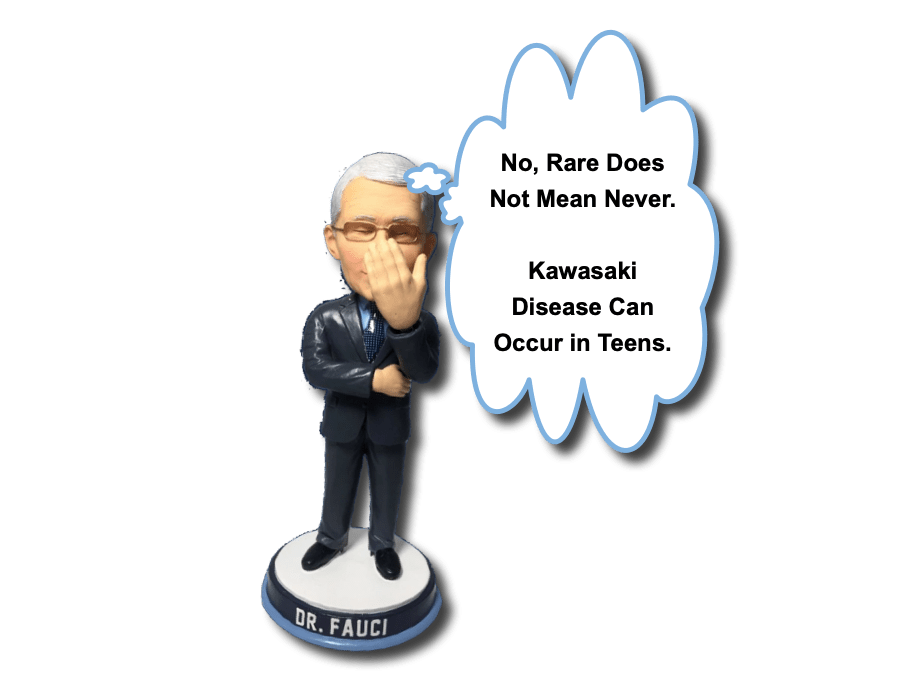Kawasaki Disease in Adolescents

We are all aware that one of the challenges of caring for children is that the issues you need to ponder vary with each age group. We know that fever is managed differently based on age (ex, 8-28 days vs 29-60 days). We know that some conditions are more prevalent amongst patients of certain ages, yet should not be considered for other ages (ex, don’t test for strep pharyngitis in toddlers). More often though, conditions do not adhere to a strict age restrictions. Sure, intussusception is most common between 3 months and 12 months of age, but it can occur at any age. Sometimes, our education and prior training may cause us to forget that Nature does not have to abide by what is written in our textbooks (for you younger clinicians, textbooks are the giant items on the shelves behind the people in virtual zoom chats – usually positioned for effect and likely covered in dust). Recently, one of our stellar Pediatric EM Fellows, Dr. Whitney Ficker reminded me of that. Most of us were taught, at some point, that Kawasaki Disease is rare, causes coronary artery aneurysms, fun to be quizzed about (AKA Pimping), and occurs in children 6 months to 5 years. That, however, it only not the full story. Let us digest a tasty treat on Kawasaki Disease in Adolescents:
Kawasaki Disease in Adolescents
Kawasaki Disease – Basics
- KD is an acute febrile vasculitis that occurs in children.
- It is the LEADING CAUSE OF ACQUIRED HEART DISEASE among children in North America and Japan.
- 85% of cases occur in children < 5 years of age (which means there are cases in older children).
- Many physicians ignore the possibility of KD completely in children > 8 years o age. [Liu, 2021]
- KD, however, can occur at any age – even in adults! [Liu, 2021]
Kawasaki Disease (KD) – Complete vs Incomplete
- Complete KD
- KD is considered confirmed by the presence of Fever for 5 or more days AND 4 of the 5 following criteria, provided that the illness cannot be explained by common mimics.
- Bilateral Conjunctival Injection
- Mucous Membrane Changes of the Upper Respiratory Tract: injected pharynx, fissured lips, strawberry tongue.
- Changes of the Peripheral Extermities: peripheral edema, peripheral erythema, periungual desquamation.
- Polymorphous Rash: it really can be almost any type of rash.
- Cervical Adenopathy
- KD is considered confirmed by the presence of Fever for 5 or more days AND 4 of the 5 following criteria, provided that the illness cannot be explained by common mimics.
- Incomplete KD
- Prolonged fever, but only 2 or 3 of the characteristic features.
- While the child has an incomplete set of criteria, she/he has as the same risk for developing coronary artery aneurysms.
- When you are entertaining this possibility, lab values (ESR/CRP) can be helpful in risk stratify the patient. [Newburger, 2004]
- It may also be a case when you actually need an ECHO done in the ED to help determine the child’s management. [Newburger, 2004].
Kawasaki Disease – “Atypical” Symptoms
- While Complete and Incomplete KD present with the “typical” clinical features noted above, KD can also present with “atypical” features.
- Atypical findings may be: [Liu, 2021; Stockheim, 2000; Cai, 2011]
- GI symptoms: vomiting, diarrhea, abdominal pain, weight loss
- Upper respiratory symptoms: cough, sore throat
- Neurologic symptoms: fatigue, headache, dizziness, tinnitus, meningeal signs
- Musculoskeletal symptoms: arthralgias, joint edema
- Atypical findings are common in adolescents, especially GI symptoms [Liu, 2021; Stockheim, 2000; Cai, 2011]
Adolescents at risk of Delayed Diagnosis of KD
- Diagnosis in adolescents is often delayed more than 12 days of symptoms [Liu, 2021; Jindal, 2020; Stockheim, 2000; Manlhiot, 2009]
- Often they are misdiagnosed first.
- Common misdiagnoses are:
- Delays in Dx likely attributed to:
- Clinical features occurring in more discrete fashion (instead of concurrently – younger patients typically had symptoms present before the 6th day of fever [Cai, 2011])
- Distracting Atypical symptoms
- Increased incidence of Incomplete presentations [Liu, 2021; Jindal, 2020; Advani, 2019; Manlhiot, 2009]
- Decreased provider awareness that KD can occur in the older age group (which we are trying to overcome at this moment)
- Of the clinical criteria, cervical lymphadenopathy is more common seen in the older age group (Cai, 2011) (Advani, 2019) (Lee, 2006)
- Of the clinical criteria, conjunctivitis, rash, mucosal changes, and hand/foot changes were less common in the older age group (Advani, 2019)
- These symptoms appeared later in the course of KD in the older age group compared to the younger patients (Cai, 2011)
- Unfortunately, the risk of coronary artery aneurysms is still high.
- Coronary artery abnormalities seen in 21-60% of cases [Liu, 2021; Advani, 2019; Cai, 2011; Manlhiot, 2009; Lee, 2006; Stockheim, 2000]
- Possibly due to:
- Delayed diagnosis
- More mature immune system resulting in a more robust inflammatory response (often need repeated IVIG treatments) [Cai, 2011]
Moral of the Morsel
- Nature laughs at our textbooks. Ok… maybe She does not laugh… but she certainly likes to remind us to remain humble and vigilant.
- Fever for > 5 days? Consider KD and ask the right questions. Since KD in adolescents is more likely to not have symptoms clustered together, make sure to do some detective work and ask if they have been present previously.
- Prolonged Fever has a wide Ddx… Keep Kawasaki Disease on it.

